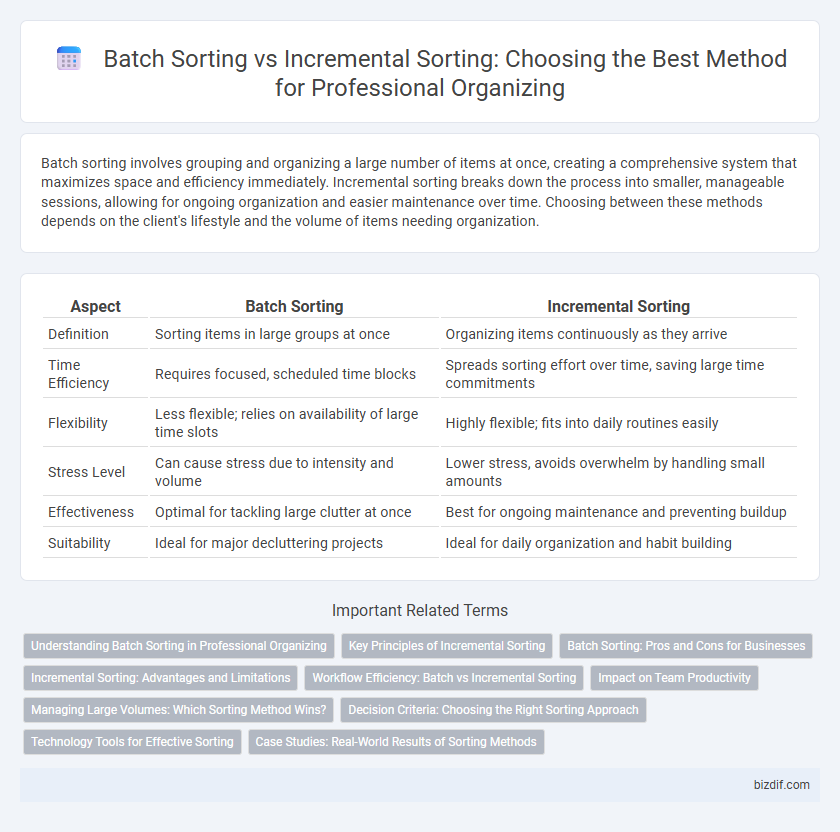Batch sorting involves grouping and organizing a large number of items at once, creating a comprehensive system that maximizes space and efficiency immediately. Incremental sorting breaks down the process into smaller, manageable sessions, allowing for ongoing organization and easier maintenance over time. Choosing between these methods depends on the client's lifestyle and the volume of items needing organization.
Table of Comparison
| Aspect | Batch Sorting | Incremental Sorting |
|---|---|---|
| Definition | Sorting items in large groups at once | Organizing items continuously as they arrive |
| Time Efficiency | Requires focused, scheduled time blocks | Spreads sorting effort over time, saving large time commitments |
| Flexibility | Less flexible; relies on availability of large time slots | Highly flexible; fits into daily routines easily |
| Stress Level | Can cause stress due to intensity and volume | Lower stress, avoids overwhelm by handling small amounts |
| Effectiveness | Optimal for tackling large clutter at once | Best for ongoing maintenance and preventing buildup |
| Suitability | Ideal for major decluttering projects | Ideal for daily organization and habit building |
Understanding Batch Sorting in Professional Organizing
Batch sorting in professional organizing involves grouping similar items or tasks and processing them all at once to maximize efficiency and reduce decision fatigue. This method enables organizers to tackle large projects by dividing them into manageable segments, enhancing overall productivity. Understanding batch sorting helps professionals streamline workflows, improve time management, and create more effective organizational systems.
Key Principles of Incremental Sorting
Incremental sorting in professional organizing involves sorting items gradually over defined intervals, allowing continuous progress without overwhelming the organizer. This method emphasizes maintaining balance by sorting small batches based on priority and category, promoting sustained motivation and minimizing decision fatigue. Key principles include consistent short sessions, immediate categorization, and periodic reassessment to adapt to evolving organizational needs.
Batch Sorting: Pros and Cons for Businesses
Batch sorting in professional organizing enables businesses to process large volumes of items or data at once, improving efficiency during peak workloads and minimizing disruption. This method supports systematic categorization, making it ideal for archival or project-based environments where accuracy and completeness are priorities. However, batch sorting may delay immediate access to individual items and requires significant time blocks, which can disrupt ongoing operations and reduce flexibility.
Incremental Sorting: Advantages and Limitations
Incremental sorting allows professionals to organize items progressively, reducing overwhelm and enabling frequent reassessments for better adaptability to changing needs. This method improves efficiency by addressing recent clutter without tackling the entire space, which is especially useful in dynamic environments like offices or busy households. However, incremental sorting might lead to inconsistent organization and overlooked areas if not periodically supplemented with comprehensive batch sorting sessions.
Workflow Efficiency: Batch vs Incremental Sorting
Batch sorting consolidates similar tasks into large groups, maximizing efficiency by minimizing the time spent switching between activities and enabling uninterrupted focus. Incremental sorting processes items in smaller, frequent batches, allowing for continuous progress and adaptability but potentially increasing task-switching overhead. Choosing between batch and incremental sorting impacts workflow efficiency based on the complexity and volume of items, with batch sorting favoring bulk organization and incremental sorting supporting ongoing maintenance.
Impact on Team Productivity
Batch sorting consolidates tasks into large groups, allowing teams to focus deeply and minimize task-switching, which significantly boosts overall productivity. Incremental sorting breaks tasks into smaller, manageable chunks, enabling continuous progress and adaptation but may introduce frequent context shifts that slightly reduce efficiency. Choosing the optimal sorting method depends on the team's workflow dynamics and project complexity to maximize effectiveness.
Managing Large Volumes: Which Sorting Method Wins?
Batch sorting processes large volumes of items all at once, making it efficient for initial organization of cluttered spaces with thousands of elements. Incremental sorting handles items in smaller, continuous chunks, allowing ongoing adjustments and easing cognitive load during extended projects. For managing large volumes, batch sorting often wins by delivering faster, comprehensive arrangement, while incremental sorting offers flexibility in dynamic environments.
Decision Criteria: Choosing the Right Sorting Approach
Batch sorting excels in handling large volumes of items quickly, making it ideal for one-time or infrequent organizing projects where efficiency is paramount. Incremental sorting suits ongoing, dynamic environments requiring continuous updates and flexibility, allowing organizers to adjust and sort as new items arrive. Decision criteria should consider project scale, frequency of sorting needs, and the necessity for adaptability to determine the most effective approach for professional organizing.
Technology Tools for Effective Sorting
Technology tools for professional organizing enhance batch sorting by enabling users to categorize large volumes of items or data efficiently through automated tagging and bulk processing features. Incremental sorting benefits from real-time updates and adaptive algorithms found in advanced software, which allow continuous organization as new information is added without the need to reprocess the entire dataset. Integration of AI-powered tools and cloud-based platforms ensures seamless synchronization and scalability, optimizing both batch and incremental sorting workflows for maximum productivity.
Case Studies: Real-World Results of Sorting Methods
Case studies reveal batch sorting enhances efficiency in large-scale professional organizing projects by grouping similar items for simultaneous processing, reducing decision fatigue and time spent. Incremental sorting proves beneficial in ongoing organization scenarios, allowing gradual categorization that adapts to evolving needs and space limitations. Metrics from these studies indicate batch sorting can reduce project time by up to 40%, while incremental sorting improves long-term maintenance and user satisfaction in dynamic environments.
batch sorting vs incremental sorting Infographic

 bizdif.com
bizdif.com